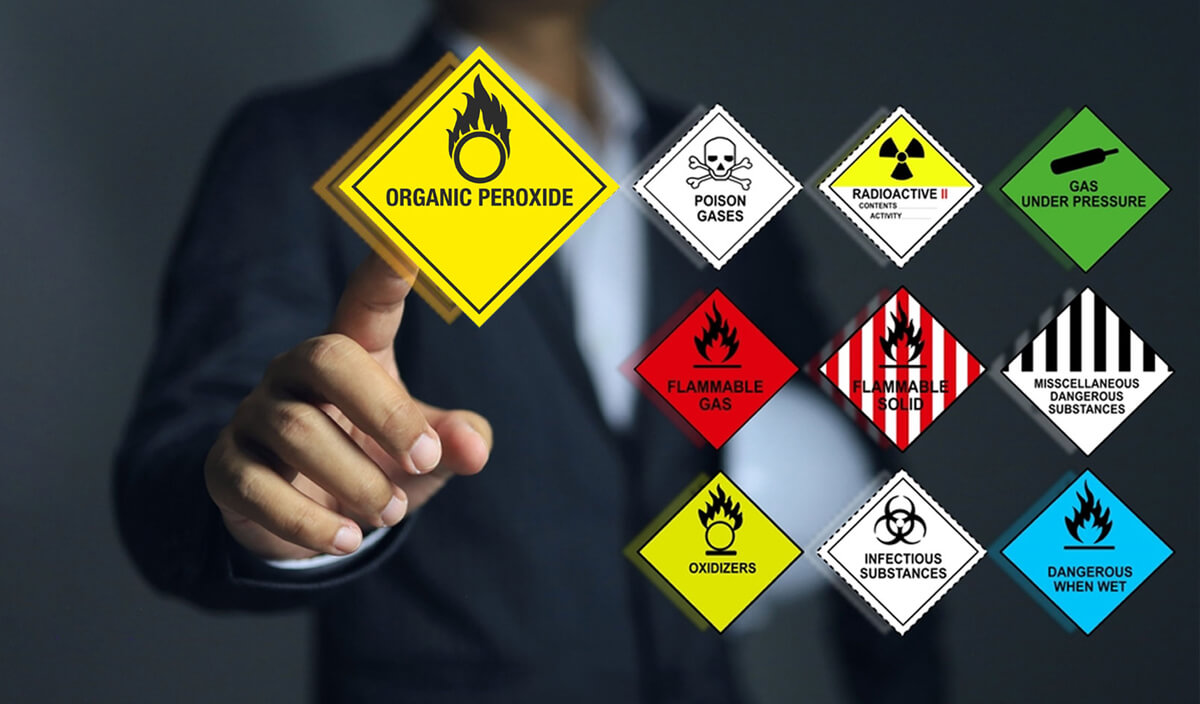The 9 Classifications of Dangerous Goods

Dangerous goods encompass materials or items possessing physical and chemical properties that, if not appropriately managed, could pose potential risks to human health, safety, and infrastructure. These goods are categorized through a classification system outlined by the UN Model Regulations, whereby each dangerous substance or article is assigned to a specific class.
There are nine classes of dangerous goods, and the classification is determined by the nature of the hazards they pose:
Class 1: Explosives
Explosives, which are capable of igniting or detonating during a chemical reaction, fall under Class 1 goods. They are hazardous due to their molecules being designed to rapidly change state, typically from a solid to a highly heated gas. Below are the six sub-divisions of explosives based on the behavior of the product when initiated:
1.1: Substances and articles presenting a hazard of mass explosion
1.2: Substances and articles with a projection hazard but not a mass explosion hazard
1.3: Substances and articles posing a fire hazard, along with a minor risk of blast or projection, or both
1.4: Substances and articles presenting no significant hazard, with only a small hazard in the event of ignition during transport, and any effects largely confined to the package
1.5: Extremely insensitive substances with a mass explosion hazard
1.6: Extremely insensitive articles without a mass explosion hazard
Ignitors, flares, and fireworks are a few examples of explosives.
Class 2: Gases
This class encompasses gases, liquefied gases, refrigerated gases, gas mixtures with other vapors, and products charged with aerosols or gases. These gas types are flammable and can be corrosive or toxic. Moreover, they are hazardous, as they have the potential to chemically react with oxygen. Gases come in three subdivisions, such as the following:
- Division 2.1: Flammable gases
- Division 2.2: Non-flammable, non-toxic gases
- Division 2.3: Toxic gases
Fire extinguishers and aerosols are the most common examples of gases.
Class 3: Flammable liquids
A flammable liquid is characterized by its low ignition temperature compared to other liquids, whether it’s a single liquid, a mixture, or one containing solids. This low ignition temperature poses a significant risk during transportation, as there’s a heightened likelihood of the liquid igniting. Consequently, flammable liquids are highly hazardous to handle and transport due to their volatile and combustible nature. They are commonly utilized as fuels in internal combustion engines for motor vehicles and aircraft, making them the primary category of dangerous goods transported via surface transport. Moreover, many household items incorporate flammable liquids, such as perfumes and acetone (commonly found in nail polish remover).
Class 4: Flammable solids
This class encompasses products highly susceptible to combustion and capable of igniting fires during transportation. Some goods within this class exhibit self-reactive properties, while others are prone to spontaneous heating. Class 4 is further divided into three sub-divisions:
Class 4.1 Flammable solids: These substances burn more readily than typical combustible materials. Their combustion is intense and rapid, posing a significant danger due to their potential for explosive decomposition, vigorous burning, or emission of toxic gases.
Class 4.2 Spontaneously combustible: These substances, whether solids or liquids, ignite spontaneously upon contact with oxygen.
Class 4.3 Dangerous when wet: These goods generate flammable gas when they react with water, which can then be ignited by the heat produced during the reaction.
Among the products that fall under flammable solids include sodium batteries, metal powders, and seed cake (oil-bearing seeds).
Class 5: Oxidizing agents and organic peroxides
Dangerous goods under this class come in two categories: ‘oxidizing agents’ and ‘organic peroxides’. These substances are highly reactive due to their elevated oxygen content, readily initiating chemical reactions with flammable or combustible materials. Consequently, fires may erupt and persist in confined spaces, posing a significant hazard. Moreover, these materials are notoriously challenging to extinguish, further increasing their level of danger.
Class 5.1 Oxidizing Agents: Also known as oxidizers, these substances have the potential to induce or enhance combustion through chemical reactions. While oxidizers may not combust independently, the oxygen they generate can trigger combustion when combined with other materials.
Class 5.2 Organic Peroxides: Characterized by their molecular structure, organic peroxides are highly susceptible to ignition, making them prone to individual combustion. These substances are engineered to be reactive for industrial purposes, rendering them unstable and potentially explosive.
Hydrogen peroxide and lead nitrate are included in class 5 dangerous goods.
Class 6: Toxins and infectious substances
Toxic substances, as implied by the name, have the potential to cause death or serious harm due to their toxicity. They can inflict severe injury or damage to human health upon ingestion, inhalation, or skin absorption. While some toxins can lead to rapid fatalities, others may cause harm only if the dosage is not excessive.
Class 6.2 Infectious Substances: These goods harbor microorganisms capable of causing infectious diseases in humans or animals, commonly referred to as pathogens.
Some of the goods that fall under this class include acidic substances, clinical waste, and medical waste.
Class 7: Radioactive material
Radioactive materials comprise atoms with unstable nuclei that undergo spontaneous and random structural changes. These materials contain ‘radionuclides,’ characterized by their unstable nucleus, which emits radioactive energy. When atoms undergo changes, they emit ionizing radiation, capable of inducing chemical or biological alterations. Such radiation poses potential dangers to the human body. Examples of radioactive materials include yellowcake and smoke detectors.
Class 8: Corrosives
Corrosives are substances with high reactivity that yield significant chemical effects. Their reactive nature initiates chemical reactions leading to the deterioration of other materials upon contact. When these materials encounter living tissue, they can inflict severe injuries. Flux, chlorides, and batteries are a few examples of corrosive substances.
Class 9: Miscellaneous dangerous goods
This category encompasses substances that pose risks not addressed by other classes. A few examples include magnetized materials, airbag modules, asbestos, marine pollutants, seatbelt tensioners, motor engines, GMOs, and dry ice.
In a Nutshell
Transporting dangerous goods presents a considerable challenge for businesses in the UAE. These goods encompass a wide range of materials and substances, typically classified into nine primary classes, some with specialized subcategories. As a commercial trader or manufacturer, it’s essential to be well-versed in the pertinent rules, regulations, and documentation procedures governing their shipment within the country.
Do you have any inquiries or require further information regarding the shipment of dangerous goods in the UAE? Our in-house team of GCAA-certified experts at TFI is available to assist you. Backed by our ISO-9001 & ISO-45001 certifications, global freight forwarding solutions, customs brokerage services, end-to-end logistics management, and DG approved warehouse, we are your qualified partner for packing, handling, and transporting dangerous goods in the UAE and globally.
Are you searching for a qualified and reliable company that offers a 360-degree solution to all your DG needs? Get in touch with our experts today!
Related Blogs
-
20 July 2023 6:47AM
7 Ways Value-Added Services Can Benefit Your Business


